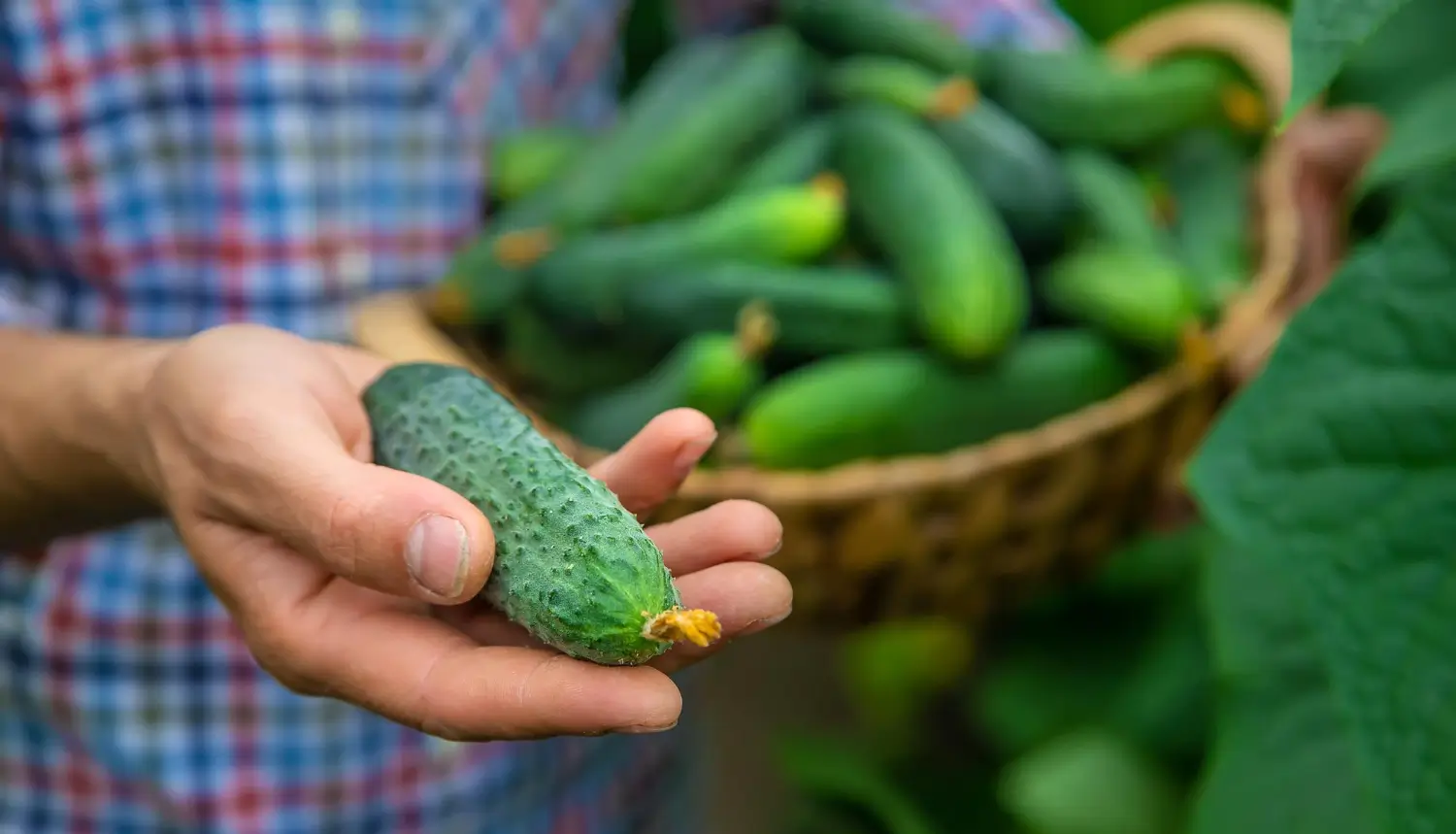
August 24, 2025

Cucumbers are one of the most widely grown vegetables worldwide due to their refreshing taste and versatility. However, cucumber plants are highly susceptible to various pests and diseases, which can significantly impact yield and quality. In recent years, many people have started to prefer organic farming because they want food that is free from harmful chemicals and safe for the environment.
Organic pest and disease control is necessary to grow healthy cucumbers without using chemical pesticides. Farmers and home gardeners can protect their crops by using natural, eco-friendly methods, keeping the soil healthy, and supporting the environment.
Growcycle provides a range of high-quality agricultural products designed to support sustainable farming practices. One of their most effective solutions for pest control is the Pest Wizard® Cucumber Beetle Kit, which captures multiple species of cucumber beetles using specialized yellow traps and pheromone lures.
Cucumber plants are vulnerable to various pests and diseases that can weaken their growth and reduce harvest quality. Here are the common pests and diseases of cucumber plants:
Using organic methods to manage pests and diseases in cucumbers offers several advantages, such as:
Organic pest and disease control reduces harm to the environment by avoiding synthetic chemicals that can pollute soil and water. Some key benefits include:
Organic pest control reduces exposure to harmful chemicals for both growers and consumers. This is important for:
Healthy soil is the foundation of productive farming. Organic practices improve soil in several ways:
Effective pest management in cucumber cultivation depends on several factors, such as preventive measures and natural control methods, which are discussed here:
Rotating cucumbers with non-related crops each season prevents the buildup of pests and soil-borne diseases. Avoid planting cucumbers in the same spot every year to reduce risks. Also, planting early or late in the season can help avoid peak pest populations.
Removing plant debris, fallen leaves, and infected plants helps prevent pests and diseases from spreading. Keeping garden tools clean reduces the risk of transferring harmful pathogens from one plant to another.
Floating row covers protect young plants from cucumber beetles and other flying pests. However, they should be removed once flowers appear to allow pollination. Planting a border of trap crops, such as radishes or nasturtiums, attracts pests away from cucumbers. Yellow sticky traps help capture flying insects like whiteflies and aphids.
Encouraging natural predators is a key strategy in organic pest control. Releasing or attracting ladybugs, lacewings, and parasitic wasps helps control aphids, caterpillars, and other harmful pests. These insects feed on pest larvae and eggs, reducing infestations naturally.
Planting dill, fennel, and alyssum flowers attracts beneficial insects by providing nectar and shelter. Maintaining a diverse garden ecosystem encourages these natural allies to thrive.
Neem oil disrupts pest feeding and reproduction, while garlic spray repels insects. Soap spray (using mild liquid soap and water) can help control soft-bodied pests like aphids and spider mites.
Organic sprays should be applied in the early morning or late evening to prevent harming beneficial insects and to reduce plant stress. Always test homemade remedies on a few leaves before applying widely.
Organic disease management focuses on selecting resistant varieties, maintaining healthy soil, improving air circulation, and using natural treatments when needed.
Some cucumber varieties are naturally resistant to powdery mildew, downy mildew, and bacterial wilt. When selecting seeds, look for varieties labeled as "disease-resistant."
Hybrid cucumbers often have built-in resistance to specific diseases, while heirloom varieties may require more care but offer unique flavors and characteristics.
Well-drained, nutrient-rich soil reduces plant stress and makes them less vulnerable to disease. Adding compost, organic mulch, and beneficial microbes improves soil structure and fertility.
Drip irrigation or soaker hoses deliver water directly to the soil, preventing moisture from sitting on leaves and reducing the risk of fungal infections. Watering in the early morning allows excess moisture to evaporate during the day.
Diseased leaves and plants should be removed immediately to prevent further spread. Avoid composting infected plant material, as some pathogens can survive in the compost pile.
Tools, gloves, and containers should be regularly disinfected, especially after handling diseased plants. Cleaning with a solution of 1 part vinegar to 9 parts water or using hydrogen peroxide can help kill pathogens.
When cucumber diseases appear, organic treatments can help manage them without harming the environment. Baking soda sprays help prevent fungal growth by creating an alkaline leaf surface. Copper-based treatments are effective against bacterial diseases but should be used sparingly to avoid soil buildup.
Organic sprays work best as a preventive measure rather than a cure. Apply in the early morning or late afternoon to avoid harming beneficial insects and to reduce plant stress.
A well-planned approach to organic gardening ensures healthy cucumber plants and a productive harvest. Here are the steps to prevent pest and disease problems while maintaining soil health and sustainability.
Proper preparation before planting sets the foundation for strong, disease-resistant cucumber plants:
Planting cucumbers correctly helps them grow strong and reduces their vulnerability to pests and diseases:
Consistent care and monitoring throughout the growing season help prevent pest and disease outbreaks:
End-of-season care is just as critical as the growing phase to prevent future issues:
Organic farming continues to develop with new technologies, research breakthroughs, and collaborative efforts that support sustainable agriculture. These advancements help farmers to improve productivity while reducing reliance on synthetic chemicals.
Modern technology is making organic farming more efficient and accessible. New tools and techniques help farmers monitor pests and diseases while maintaining eco-friendly practices.
Scientific research continues to shape the future of organic farming by improving disease resistance and promoting natural pest control methods.
What is the best pest control for cucumbers?
The best pest control for cucumbers includes organic methods, such as neem oil, insecticidal soap, and beneficial insects (such as ladybugs). Floating row covers and trap crops can also help prevent pest infestations.
What is the best fungicide for cucumbers?
Copper-based treatments and baking soda sprays are the best organic fungicides for cucumbers. These help control fungal diseases like powdery mildew and downy mildew. Always apply them as a preventive measure.
How to control cucumber plants?
Control cucumber plants by practicing crop rotation, using trellises for vertical growth, maintaining proper spacing, and applying organic pest and disease control methods like neem oil and beneficial insects.
Cucumber farming requires careful attention to pest and disease control to ensure healthy crops. Using natural predators, organic sprays, and disease-resistant cucumber varieties, farmers and home gardeners can grow cucumbers without harmful chemicals, making the food safer and better for the environment.
Tools like pest monitoring apps, AI-based systems, and disease-resistant varieties will help farmers manage cucumber pests and diseases more effectively and reduce their environmental impact. Explore Growcycle to buy the best gardening products and tools for cucumber cultivation.
Disclaimer: This material is for informational purposes only and should not be relied on for legal, medical, financial, or any other form of professional advice.